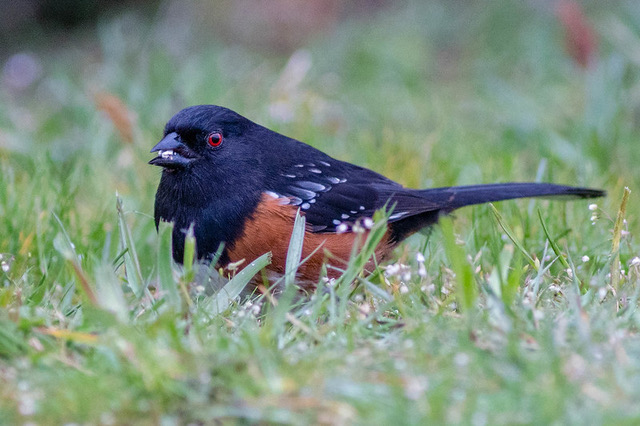by Barbara Faurot •
As our plants enter the dormant months of winter, our gardens and forests continue to teem with life. A host of sparrows inspects the ground to find seeds. A tangle of towhees pecks away, in search of crickets. Pacific chorus frogs, now solitary in their habits, shelter in the debris to hibernate for the winter.
Leaves, bud scales, twigs, needles, fruits, and bark fragments all accumulate on the ground to form a layer of debris known as “duff.” The duff layer, a few inches above the soil, is one of the most vibrant and biodiverse parts of the forest or garden.
Organic materials in the duff layer are decomposed by bacteria and fungi, making nutrients available to a wide variety of flora and fauna. Our Jefferson County winters are mild enough for many to survive the cold, if they luck into a safe, warm spot with access to prey. Songbirds, frogs, toads, spiders, and other beneficial insects can rely on duff’s rich source of food and debris for overwintering.
Different species have adapted to find what they need. Robins find earthworms; thrushes search for snails; grosbeaks and buntings select nesting materials. Many creatures nest and sleep in the duff as well. Some terrestrial amphibians like American toads are good diggers and can safely burrow deep into the soil below the frost line. The wood frog and the spring peeper are not as adept at digging, so they are not well protected from cold weather. They seek out cracks and crevices in logs or rocks, or dig down as far as they can in the leaf litter.
“Duff is the blanket of winter care for many creatures, notably amphibians,” advises Mary Robson, local author, co-host of KPTZ radio’s “Nature Now,” and retired horticulture educator. “Duff is protection, and, in a way, the layered history of the forest around it.”
Mary adds that in addition to nutrient capture and release, a natural layer of duff has other practical benefits. It can help prevent weeds from sprouting by forming a protective layer between the soil and the sunlight. Duff also helps retain soil moisture and regulate soil temperature. It protects the soil and prevents erosion by absorbing and deflecting runoff water and wind.
The term “duff” is believed to be of Scottish origin, related to the word “dowf,” meaning decay. It’s sometimes called “nature’s mulch,” but that can be misleading. Typical commercial mulches have a uniform content and appearance. Natural duff can seem messier, yet for wildlife gardeners, having some duff in the garden is the goal. The variety of materials, microorganisms, and predators contributes to healthy soil, rich in organic matter. As the litter breaks down, nutrients such as phosphorus become available to understory plants and tree seedlings.
For all these reasons, wildlife — and plants — emphatically prefer duff.
As you work in your yard, garden, or backyard forest, think of duff as something to encourage among your trees, shrubs, and perennials. Gardeners can mimic the natural forest duff process by layering organic matter on top of the soil. Build or amend your own mulch, including such materials as wood chips, partially composted leaves, small twigs, lichen and moss fragments, and conifer needles.
You’ll be helping build healthy soil. At the same time, you’re offering food and shelter to the wildlife that shares your garden. When the spring peepers begin their chorus in February, we’ll know that they have spent the winter hiding out in the duff that we have left for them.
Firewise Note: It’s important to avoid heavy accumulations of duff and slash, which can become a fire risk, especially during a dry season. The Washington State Department of Natural Resources offers some useful information about firewise practices for the home garden at www.dnr.wa.gov.
If you have questions about any aspect of home gardening, Master Gardeners at the Online Plant Clinic are always available to help: https://extension.wsu.edu/jefferson/gardening-2/plant-clinic/.
Barbara Faurot is a Jefferson County Master Gardener and Master Pruner, working with other volunteers who serve as community educators in gardening and environmental stewardship.
Published in the Port Townsend Leader, December 8, 2020


